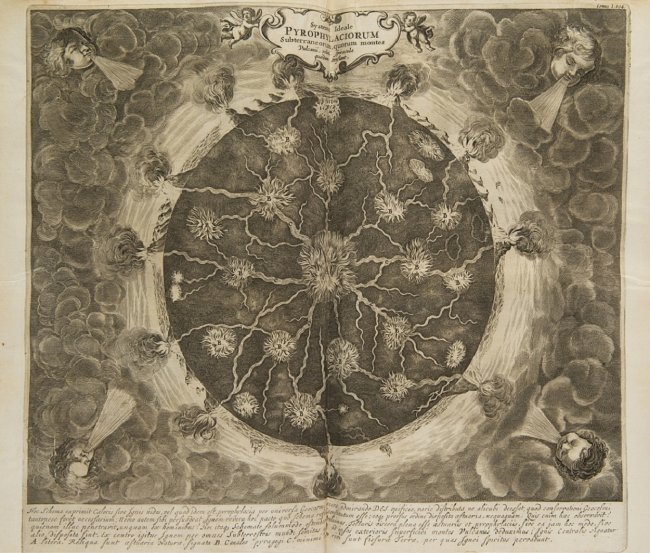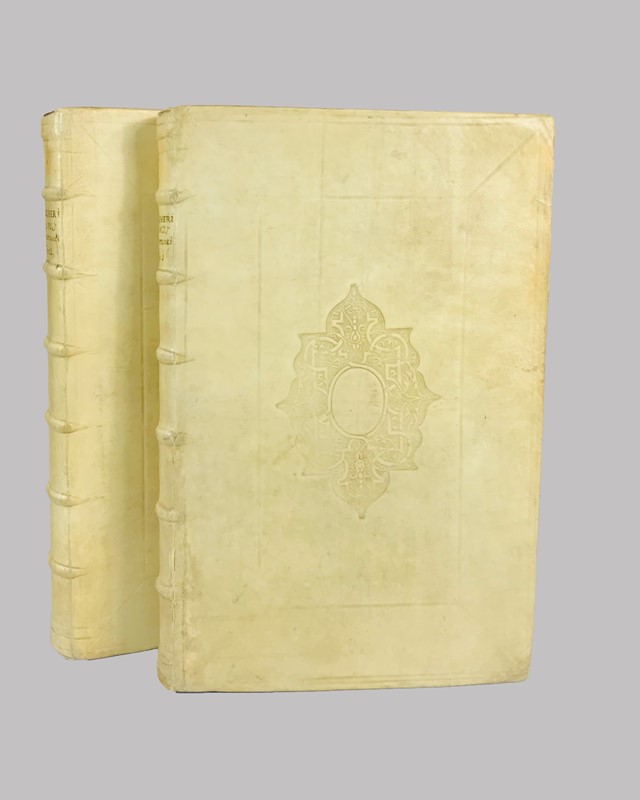KIRCHER, ATHANASIUS. Mundus Subterraneus, in XII Libros digestus. Amsterdam: J. Jansson and E. Weyerstraat, 1665. 2 vols. in one, folio, 354 x 224 mm. (13 15/16 x 8 15/16 in.), seventeenth- or eighteenth-century vellum over pasteboards, flat spine lettered in ink, edges blue-sprinkled, upper inner hinge cracked, fore-margin of vol. 1 engraved title strengthened, folding map of Southeast Asia (bound in after p. I:70) cropped, double-page lunar map detached and with small internal fold break, 2-inch tear to Mediterranean map, a few short fold breaks to folding plates, scattered light spotting, some faint mostly marginal dampstaining . FIRST EDITION, 2 engraved titles, letterpress title to vol. 1 with engraved vignette, engraved portraits of the author and Pope Alexander VII, 21 engraved plates and maps including 8 folding, 4 double-page, and 2 small plates, one an engraving bound in after p. II:384, the other a woodcut after p. II:30 (often found pasted in), 7 inserted double-page or folding letterpress tables, plus 2 inserted engravings of volvelles in vol. I (bound in after pp. 132 and 154), which in this copy were not cut out and applied to the woodcuts on the facing pages, numerous engraved and woodcut text illustrations, woodcut head- and tail-pieces. Caillet 5783; Ferguson I, p. 467; Norman 1218; Sabin 37967; Nissen ZBI 2196. A very good copy of the Jesuit polymath's influential encyclopaedic survey of the subterranean or "hidden" world. Based on his experiences of the eruption of Vesuvius in 1637 and the 14 days of earthquakes that shook Calabria in 1638, Kircher attempts in the work to show that the subterranean world is composed of two interlocking systems of fire and water. Representing the first serious effort to describe the physical makeup of the earth, the book is full of extravagant theories, some of greater scientific potential than others, in the areas of physics, geography, geology and chemistry. While Kircher was the first, for example, to suggest the existence of a vast network of underground springs and reservoirs, and the first to voice the theory that temperatures below the earth's surface increase in proportion to depth, he also elaborated an interpretation of fossils as the expression of a " spiritus plasticus in the earth analogous to the vital forces controlling the growth and development of organisms...[and] illustrated his work with a fantastic collection of supposed natural 'images' in stone -- including letters of the alphabet and a Madonna..." (Norman). The world map (Shirley 436) was one of the earliest to show ocean currents with any degree of accuracy. Provenance : A few contemporary marginalia ( some cropped ).
KIRCHER, ATHANASIUS. Mundus Subterraneus, in XII Libros digestus. Amsterdam: J. Jansson and E. Weyerstraat, 1665. 2 vols. in one, folio, 354 x 224 mm. (13 15/16 x 8 15/16 in.), seventeenth- or eighteenth-century vellum over pasteboards, flat spine lettered in ink, edges blue-sprinkled, upper inner hinge cracked, fore-margin of vol. 1 engraved title strengthened, folding map of Southeast Asia (bound in after p. I:70) cropped, double-page lunar map detached and with small internal fold break, 2-inch tear to Mediterranean map, a few short fold breaks to folding plates, scattered light spotting, some faint mostly marginal dampstaining . FIRST EDITION, 2 engraved titles, letterpress title to vol. 1 with engraved vignette, engraved portraits of the author and Pope Alexander VII, 21 engraved plates and maps including 8 folding, 4 double-page, and 2 small plates, one an engraving bound in after p. II:384, the other a woodcut after p. II:30 (often found pasted in), 7 inserted double-page or folding letterpress tables, plus 2 inserted engravings of volvelles in vol. I (bound in after pp. 132 and 154), which in this copy were not cut out and applied to the woodcuts on the facing pages, numerous engraved and woodcut text illustrations, woodcut head- and tail-pieces. Caillet 5783; Ferguson I, p. 467; Norman 1218; Sabin 37967; Nissen ZBI 2196. A very good copy of the Jesuit polymath's influential encyclopaedic survey of the subterranean or "hidden" world. Based on his experiences of the eruption of Vesuvius in 1637 and the 14 days of earthquakes that shook Calabria in 1638, Kircher attempts in the work to show that the subterranean world is composed of two interlocking systems of fire and water. Representing the first serious effort to describe the physical makeup of the earth, the book is full of extravagant theories, some of greater scientific potential than others, in the areas of physics, geography, geology and chemistry. While Kircher was the first, for example, to suggest the existence of a vast network of underground springs and reservoirs, and the first to voice the theory that temperatures below the earth's surface increase in proportion to depth, he also elaborated an interpretation of fossils as the expression of a " spiritus plasticus in the earth analogous to the vital forces controlling the growth and development of organisms...[and] illustrated his work with a fantastic collection of supposed natural 'images' in stone -- including letters of the alphabet and a Madonna..." (Norman). The world map (Shirley 436) was one of the earliest to show ocean currents with any degree of accuracy. Provenance : A few contemporary marginalia ( some cropped ).











Testen Sie LotSearch und seine Premium-Features 7 Tage - ohne Kosten!
Lassen Sie sich automatisch über neue Objekte in kommenden Auktionen benachrichtigen.
Suchauftrag anlegen